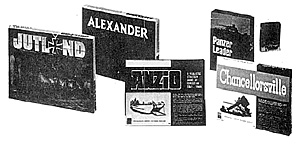
This is another of the AH mail-order line but this one is not an old AH title being resurrected. As many of you will know, it was formerly a part of our Guidon Games line. AH was so impressed with it that they decided to pruchase the rights to it. This, however is a revised version, both physically and in the rules.
Physically, of course, it matches ANZIO and CHANCELLORSVILLE with the shallow, flat box and 22"x28" mounted board. You also get a 24-page, 5 1/2"x8" booklet containing the rules. historical summary, designer's notes, and questions and answers on conduct of play, one 8 1/2"X11" CRT-card, and a 7 5/8"x7 1/8" sheet of unit counters. The hexes on the mapboard are considerably smaller than those on the GG version (1" from side to side instead of 1 1/4"), and instead of the 1/2"x1' retangular counters they use ordinary 1/2" squares, and 3/4" square phalanx counters instead of the former 1" squares.
One result of the smaller counters (or vice versa) is that units now have only front, flank and rear combat factors instead of seperate (and often different) left and right flank factors.
The basic rules are changed very little from the GG version. For the sake of those not familiar with ALEX: it is a tactical game simulating the battle of Guagamela (or Arbela), 20 Sep 331 B.C. between the Macedonians, Greeks and allied contingents under Alexander, the Macedonian king, and the polyglot forces of the Persian Empire under their emperor, Darius.
The Persians outnumbered the Macedonians by about 100,000 to 50,000, but the latter were all well-trained, well-equiped veterans, while most of the Persians were lightly armed, poorly trained levees. This was the third, the largest and the decisive battle between Alexander and the Persians, and when it was over he had won himself an empire.
The Advanced Game introduces some ideas not found in the GG version, the major one being the charging of movement points for changing a unit's facing direction by more than one side per hex moved through.
Another new feature is the printing on the mapboard of historical starting positions for both sides - their use, however, is strictly optional. Also printed on the mapboard are a Morale Status Gauge MSG and a Temporary Morale Scale TMS, which facilitate keeping track of the morale of each side. For ALEX has a unique morale aspect of various things, such as losing units, eliminating enemy units. loss of commanders or baggage camps, raise or lower each side's morale each turn.
The TMS is for keeping track of the gains and losses within one turn. The MSG keeps track of each side's overall Status. At the end of each turn the net gain or loss reflected for each side on the TMS is used to adjust the MSG. Using these charts on the board is some improvement over the pencil-and-paper method required Vith the old version. There are four CRTs, each for one of four possible Attacker's morale levels. And within each CRT, at each odds level there is a separate line for each of the four Possible levels of Defender morale level. Naturally, the lower your army's morale level the worse it'll do in either attack or defense. And one way to win the game is to reduce your opponent's morale level to zero. The CRTS are unchanged from the original version.
The final change to note is that, while the AH version retains the 2-step loss system of the GG version, they did not print the strength step on the backs of the counters, as we did, but leave it up to the players to do the halving mentally when using inverted counters, or to write the half strengths on the backs of the counters themselves. And for some inexplicable reason AH has returned, with this game, to the use of baby-blue and pink for their unit counters.
Gary Gygax designed the original ALEXANDER (itself a development of Gary's earlier ARBELA) and worked on the redesign with Donald Greenwood. The AH components were designed by Donald Greenwood, Randy Reed and Tom Shaw, with artwork by W. Scott Moores. Avalon Hill rates ALEXANDER's complexity level as Intermediate II, along with D-DAY, ORIGINS and MIDWAY, and that seems about right to me,
The price is $8.00 plus postage and is worth it if you're interested in ancient warfare or a board game that is truly unique mechanically. It, too, is available from PANZERFAUST.
Complexity Level
- Alexander the Great Intermediate II
Anzio Tournament II
Jutland Tournament II
Chancellorsville Intermediate III
Third Reich Tournament IV
Panzer Leader Tournament IV
More Six From Avalon Hill Game Profiles
-
Rise and Decline of the Third Reich
Chancellorsville
Anzio
Alexander the Great
Jutland
Panzer Leader
Back to Table of Contents -- Panzerfaust #66
To Panzerfaust/Campaign List of Issues
Back to MagWeb Master Magazine List
© Copyright 1974 by Donald S. Lowry
This article appears in MagWeb (Magazine Web) on the Internet World Wide Web. Other military history articles and gaming articles are available at http://www.magweb.com